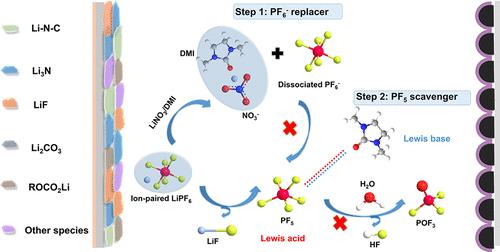当前位置:
X-MOL 学术
›
ACS Appl. Mater. Interfaces
›
论文详情
Our official English website, www.x-mol.net, welcomes your
feedback! (Note: you will need to create a separate account there.)
Novel Urea-Based Molecule Functioning as a Solid Electrolyte Interphase Enabler and LiPF6 Decomposition Inhibitor for Fast-Charging Lithium Metal Batteries
ACS Applied Materials & Interfaces ( IF 8.3 ) Pub Date : 2022-08-18 , DOI: 10.1021/acsami.2c11403 Pan Zhou 1 , Yingchun Xia 1 , Yuhao Wu 1 , Wen-Hui Hou 1 , Yang Lu 1 , Shuai Shuai Yan 1 , Hang-Yu Zhou 1 , Weili Zhang 1 , Kai Liu 1
ACS Applied Materials & Interfaces ( IF 8.3 ) Pub Date : 2022-08-18 , DOI: 10.1021/acsami.2c11403 Pan Zhou 1 , Yingchun Xia 1 , Yuhao Wu 1 , Wen-Hui Hou 1 , Yang Lu 1 , Shuai Shuai Yan 1 , Hang-Yu Zhou 1 , Weili Zhang 1 , Kai Liu 1
Affiliation

|
The practical application of lithium metal batteries is impeded by the growth of dendrites and decomposition of electrolytes especially at high temperature in normal carbonate-based electrolytes. Herein, a novel urea-based molecule, 1,3-dimethyl-2-imidazolidinone (DMI), with a high donor number is proposed, which exhibits an extraordinary solubility of LiNO3 of over 5 M. As a result, a sufficient amount of LiNO3 is readily introduced into the carbonate electrolytes with DMI as an additive, and an average coulombic efficiency of 99.1% for lithium plating/stripping is achieved due to a stable solid electrolyte interphase (SEI) rich in inorganic-rich lithium salts. The Li||Li symmetric cell achieves a stable operation for over 2500 h at 0.5 mA cm–2 and 1 mAh cm–2, and a granular shape of deposited Li metal is still preserved even at a high current density of 10 mA cm–2. Besides, the decomposition of LiPF6 is inhibited benefiting from its enhanced dissociation after the addition of DMI/LiNO3 and DMI’s function as a PF5 scavenger. Consequently, the Li||LiFePO4 cell succeeds to achieve an excellent capacity retention of 95.6% after 2200 cycles at a high rate of 5C, and a stable operation is realized at a high temperature of 60 °C even under harsh conditions (45 μm ultrathin Li and ∼1.5 mAh cm–2 LiFePO4). This work enriches the solvents and additives pool for stable and high-performance lithium metal batteries and will shed light on future developments of advanced battery electrolytes.
中文翻译:

新型尿素基分子作为快速充电锂金属电池的固体电解质界面促进剂和 LiPF6 分解抑制剂
锂金属电池的实际应用受到枝晶生长和电解质分解的阻碍,特别是在高温下在普通碳酸盐基电解质中。在此,提出了一种新型的脲基分子,1,3-二甲基-2-咪唑啉酮 (DMI),它具有高供体数,其对 LiNO 3的溶解度超过 5 M。因此,足量的使用 DMI 作为添加剂, LiNO 3很容易被引入到碳酸盐电解质中,并且由于富含富含无机物的锂盐的稳定固体电解质界面 (SEI) 实现了 99.1% 的锂电镀/剥离的平均库仑效率。Li||Li 对称电池在 0.5 mA cm –2和 1 mAh cm下实现了超过 2500 小时的稳定运行–2 ,即使在 10 mA cm –2的高电流密度下,沉积的锂金属仍保持颗粒状。此外,由于添加DMI/LiNO 3后LiPF 6 的解离增强和DMI作为PF 5清除剂的作用,LiPF 6的分解受到抑制。因此,Li||LiFePO 4电池在 5C 的高倍率下在 2200 次循环后成功实现了 95.6% 的优异容量保持率,即使在苛刻的条件下(45 μm超薄锂和~1.5 mAh cm –2 LiFePO 4)。这项工作丰富了稳定和高性能锂金属电池的溶剂和添加剂池,并将阐明先进电池电解质的未来发展。
更新日期:2022-08-18
中文翻译:

新型尿素基分子作为快速充电锂金属电池的固体电解质界面促进剂和 LiPF6 分解抑制剂
锂金属电池的实际应用受到枝晶生长和电解质分解的阻碍,特别是在高温下在普通碳酸盐基电解质中。在此,提出了一种新型的脲基分子,1,3-二甲基-2-咪唑啉酮 (DMI),它具有高供体数,其对 LiNO 3的溶解度超过 5 M。因此,足量的使用 DMI 作为添加剂, LiNO 3很容易被引入到碳酸盐电解质中,并且由于富含富含无机物的锂盐的稳定固体电解质界面 (SEI) 实现了 99.1% 的锂电镀/剥离的平均库仑效率。Li||Li 对称电池在 0.5 mA cm –2和 1 mAh cm下实现了超过 2500 小时的稳定运行–2 ,即使在 10 mA cm –2的高电流密度下,沉积的锂金属仍保持颗粒状。此外,由于添加DMI/LiNO 3后LiPF 6 的解离增强和DMI作为PF 5清除剂的作用,LiPF 6的分解受到抑制。因此,Li||LiFePO 4电池在 5C 的高倍率下在 2200 次循环后成功实现了 95.6% 的优异容量保持率,即使在苛刻的条件下(45 μm超薄锂和~1.5 mAh cm –2 LiFePO 4)。这项工作丰富了稳定和高性能锂金属电池的溶剂和添加剂池,并将阐明先进电池电解质的未来发展。

































 京公网安备 11010802027423号
京公网安备 11010802027423号